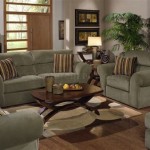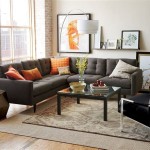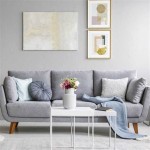Types of Chairs in a Living Room
The living room serves as a central hub for relaxation, entertainment, and social interaction within a home. The selection of chairs significantly impacts the room's functionality, aesthetics, and overall comfort. A diverse range of chair types exists, each offering unique characteristics and suitability for different purposes and design preferences. This article presents an overview of common chair types found in living rooms, highlighting their defining features and intended applications.
Armchairs: The Classic Comfort
Armchairs represent a staple choice for living room seating, characterized by their supportive arms and comfortable design. Their versatility allows for placement as standalone pieces or in coordinated sets, complementing sofas and other seating arrangements. Armchairs are available in numerous styles, materials, and sizes, catering to diverse aesthetic tastes and spatial limitations. The armrests provide added support and comfort, making them ideal for reading, relaxing, or engaging in conversation.
Several subcategories exist within the armchair category, each with distinct features:
- Traditional Armchairs: Typically feature a classic silhouette with rolled arms, often upholstered in rich fabrics like velvet or leather. They often incorporate decorative elements such as nailhead trim or button tufting.
- Modern Armchairs: Embrace clean lines, minimalist designs, and contemporary materials like metal and synthetic fabrics. They prioritize functionality and often incorporate ergonomic features.
- Mid-Century Modern Armchairs: Characterized by organic shapes, tapered legs, and a combination of natural materials like wood and fabric. They offer a retro aesthetic with a focus on comfort and style.
- Wingback Chairs: Distinguished by their high backs and winged sides, offering enhanced privacy and protection from drafts. They often convey a sense of formality and elegance.
The selection of an armchair should consider the overall style of the living room, the intended use of the chair, and the available space. Larger armchairs provide greater comfort but may overwhelm smaller rooms, while smaller armchairs offer versatility and adaptability.
Accent Chairs: Adding Style and Personality
Accent chairs serve as decorative pieces, adding visual interest and personality to a living room. Unlike armchairs, which prioritize comfort and support, accent chairs often prioritize aesthetics and unique design elements. They can serve as focal points, introducing color, texture, and pattern to the space. Accent chairs typically have a more striking design and can be used to create contrast or complement existing furniture.
Common examples of accent chairs include:
- Slipper Chairs: Low-profile chairs without arms, often used in bedrooms or living rooms as occasional seating. They have a minimalist design and are typically upholstered in decorative fabrics.
- Barrel Chairs: Featuring a curved back that resembles a barrel shape, these chairs offer a cozy and inviting seating option. They are available in various styles, from traditional to modern.
- Chaise Lounges: Long, upholstered chairs designed for reclining, offering a luxurious and comfortable relaxation option. They typically have an angled back and a supportive armrest.
- Ottomans: While strictly speaking, not chairs, ottomans can function as seating and often pair with armchairs. They can also serve as footrests or coffee tables, adding versatility to the living room.
When selecting accent chairs, the focus should be on complementing the existing décor and introducing visual interest. Consider the scale, color, and texture of the chair in relation to the overall design of the living room. Accent chairs can be strategically placed to fill empty corners, define seating areas, or add a pop of color to a neutral space.
Recliners: Relaxation and Comfort Prioritized
Recliners focus on providing optimal comfort and relaxation, featuring a reclining mechanism that allows the user to adjust the backrest and footrest. They are often chosen for their ergonomic benefits and ability to alleviate pressure on the spine and joints. Recliners come in various styles, from traditional to contemporary, and offer a range of features, including power recline, massage functions, and built-in heating.
Different types of recliners cater to different needs and preferences:
- Traditional Recliners: Typically feature a bulky design with plush upholstery and a lever-activated reclining mechanism. They prioritize comfort and often incorporate features like padding and lumbar support.
- Wall-Hugger Recliners: Designed to save space, these recliners can be placed close to the wall without requiring excessive clearance for reclining. The seat slides forward as the back reclines, maximizing space efficiency.
- Power Recliners: Utilize electric motors to control the reclining mechanism, allowing for smooth and effortless adjustments. They often feature remote controls or built-in buttons for ease of use.
- Lift Chairs: Designed for individuals with mobility issues, these chairs feature a lifting mechanism that assists the user in standing up and sitting down. They offer enhanced safety and independence.
When selecting a recliner, consider the available space, the user's needs, and the desired level of comfort. Power recliners offer convenience and ease of use, while wall-hugger recliners are ideal for smaller spaces. The upholstery material should be durable and easy to clean, and the frame should be sturdy and supportive.
Loveseats: Intimate Seating Options
Loveseats are smaller versions of sofas, designed to accommodate two people comfortably. They offer an intimate seating option for couples or small families and can be used in conjunction with armchairs or sofas to create a cohesive seating arrangement. Loveseats are available in various styles, from traditional to modern, and can be upholstered in a wide range of fabrics and materials.
The selection of a loveseat depends on the available space and the desired aesthetic:
- Traditional Loveseats: Often feature a classic design with rolled arms, button tufting, and ornate detailing. They typically convey a sense of formality and elegance.
- Modern Loveseats: Embrace clean lines, minimalist designs, and contemporary materials. They prioritize functionality and often feature sleek silhouettes and neutral colors.
- Sectional Loveseats: Designed to be combined with other sectional pieces, these loveseats offer flexibility and customization in seating arrangements. They can be configured to fit various room sizes and layouts.
Consider the overall style of the living room and the intended use of the loveseat when making a selection. Loveseats can serve as a primary seating option in smaller living rooms or as a complementary piece in larger spaces.
Benches and Ottomans as Flexible Seating
Benches and ottomans, while often considered accent pieces or footrests, can also function as flexible seating options in a living room. They offer versatility and can be easily moved around to accommodate different seating arrangements or activities. Benches provide a simple and elegant seating solution, while ottomans offer a comfortable place to rest feet or serve as impromptu coffee tables.
The use of benches and ottomans as seating offers several advantages:
- Flexibility: Benches and ottomans can be easily moved around to accommodate different seating arrangements and activities. They can be used as extra seating for guests or as a footrest while watching television.
- Space-Saving: Benches and ottomans typically have a smaller footprint than traditional chairs or sofas, making them ideal for smaller living rooms. They can be tucked away when not in use, freeing up valuable floor space.
- Storage: Some benches and ottomans feature built-in storage compartments, providing a convenient place to store blankets, pillows, or other items.
When selecting benches and ottomans for seating, consider the style of the living room and the intended use. Upholstered benches offer a comfortable seating option, while wooden benches provide a more rustic and informal feel. Ottomans can be upholstered in a variety of fabrics and materials to complement the overall décor.
Choosing the right types of chairs for a living room requires careful consideration of various factors, including available space, budget, functionality, and desired aesthetic. Understanding the different chair types and their unique characteristics allows for the creation of a comfortable, stylish, and functional living space that meets individual needs and preferences.

Different Chairs Outlet In Living Room
Types Of Living Room Furniture

Types Of Chairs 14 Modern That Are High On Style
Types Of Living Room Furniture

12 Different Types Of Chairs That Can Elevate Your Home Decor Italica

20 Different Types Of Chairs Designs For Living Room Bedroom

8 Types Of Furniture For Your Living Room Fella Design

20 Different Types Of Chairs Designs For Living Room Bedroom

12 Best Affordable Living Room Chair Types Of 2024 That You Can T Skip

Different Types Of Chair Designs You Should Know About Beautiful Homes








